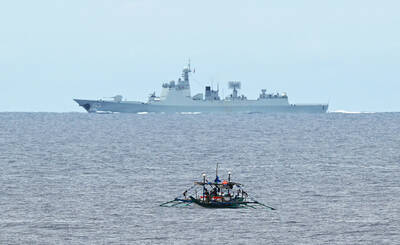The Universal Ballet of Korea won over Taipei dance fans a year ago with its full-length ballet Shim Chung, which combines classical Western ballet with a famous Korean folktale. This year the company is returning with much more modern fare to show just what its traditionally trained dancers are capable of.
The program would be a heady stretch for any company, featuring pieces by some of the most famous names in contemporary ballet and dance — Czech Jiri Kylian, American William Forsythe and Israeli Ohad Naharin — but is even more so for a company known for dancers schooled along traditional Russian academic lines — those of the Kirov Ballet’s (now St Petersburg) Vaganova style.
Unlike last year, the entire 70-plus company won’t be coming, just 34 dancers, who will perform in both tomorrow night’s show and Sunday’s matinee, said Wang Tzer-shing (王澤馨), whose firm, Art Wave Inc, is once again sponsoring the troupe.

Photo courtesy of Art Wave Inc
The two Kylian pieces on the program both use music by Wolfgang Amadeus Mozart, but Petite Mort and Sechs Tanze (Six Dances) are very different in scope and style. The 17-minute Petite Mort was created for the Salzburg Festival in 1991 to mark the second centenary of Mozart’s death. It features six women, six men and six foil sculptures that the dancers dance with, which sometimes appear to have minds of their own.
“Pette Morte is very classical, very lyrical; it’s just that the girls are not on point. It has beautiful lines and it is very difficult for the dancers to balance with the forms and not drop them. It’s very challenging for the dancers,” Wang said in a telephone interview on Tuesday.
“For Six Dances, there is a lot a acting and comedy in the ballet. Sometimes for Asian dancers comedy is the most difficult thing — how to make the audience laugh. But I saw them dance the piece in Seoul and they did a wonderful job of making the people laugh,” she said.

Photo courtesy of Art Wave Inc
While the company suggested bringing the two Kylian pieces, Wang was the one pressing them to include Germany-based Forsythe’s In the Middle, Somewhat Elevated, which was created for the Paris Opera Ballet in 1987. In the repertory of several major ballet companies, it is probably Forsythe’s most frequently performed work. Taipei dance fans who saw the 2010 International Ballet Star Gala were able to catch a brief snippet of the piece when Lorena Feijoo and Vitor Luiz of the San Francisco Ballet performed its pas de deux.
“We really, really wanted Somewhere once we knew they did it, because the whole piece has never been seen here,” Wang said. “In Seoul at the end of last year they showed us the DVD [of the company’s version] — it was great ... the ballet master from the Forsythe company was there and said that they [Universal] are doing it better than some European companies.”
Dance fans who saw the Batsheva Dance Company when it was at the National Theater in October 2010 may find something familiar about the final work on Universal’s program, Naharin’s Minus 7. Batsheva’s director and choreographer is famous for reworking and reorganizing his dances, combining bits and pieces from different works. Minus 7 incorporates segments from Zachacha, Mabul and Anaphaza, some of which — the chair dance, some of the quieter duets and set pieces, and the invitation to some audience members to join the dancers on stage — were included in Deca Dance 2010, performed in Taipei by Batsheva.
“The company suggested Minus 7. It is a very challenging piece for classically trained dancers and a very exciting piece,” Wang said. “I was laughing when I saw the piece, dancers inviting audience members. At the beginning the Universal group was worried how Taiwanese audiences would react. I think the audience will really enjoy it.”
Wang admitted that she’s concerned the title of the program, This Is Modern, may turned some balletomanes off, noting that “even friends of mine see the title and they think it’s not ballet,” but she stressed that despite the very modern pieces, the show is definitely one ballet fans will enjoy.
“All three choreographers were classically trained, they all danced with ballet companies before becoming choreographers,” she said. “It’s going to be fun.”

Late last month Philippines Foreign Affairs Secretary Theresa Lazaro told the Philippine Senate that the nation has sufficient funds to evacuate the nearly 170,000 Filipino residents in Taiwan, 84 percent of whom are migrant workers, in the event of war. Agencies have been exploring evacuation scenarios since early this year, she said. She also observed that since the Philippines has only limited ships, the government is consulting security agencies for alternatives. Filipinos are a distant third in overall migrant worker population. Indonesia has over 248,000 workers, followed by roughly 240,000 Vietnamese. It should be noted that there are another 170,000

Enter the Dragon 13 will bring Taiwan’s first taste of Dirty Boxing Sunday at Taipei Gymnasium, one highlight of a mixed-rules card blending new formats with traditional MMA. The undercard starts at 10:30am, with the main card beginning at 4pm. Tickets are NT$1,200. Dirty Boxing is a US-born ruleset popularized by fighters Mike Perry and Jon Jones as an alternative to boxing. The format has gained traction overseas, with its inaugural championship streamed free to millions on YouTube, Facebook and Instagram. Taiwan’s version allows punches and elbows with clinch striking, but bans kicks, knees and takedowns. The rules are stricter than the

“Far from being a rock or island … it turns out that the best metaphor to describe the human body is ‘sponge.’ We’re permeable,” write Rick Smith and Bruce Lourie in their book Slow Death By Rubber Duck: The Secret Danger of Everyday Things. While the permeability of our cells is key to being alive, it also means we absorb more potentially harmful substances than we realize. Studies have found a number of chemical residues in human breast milk, urine and water systems. Many of them are endocrine disruptors, which can interfere with the body’s natural hormones. “They can mimic, block

Next week, candidates will officially register to run for chair of the Chinese Nationalist Party (KMT). By the end of Friday, we will know who has registered for the Oct. 18 election. The number of declared candidates has been fluctuating daily. Some candidates registering may be disqualified, so the final list may be in flux for weeks. The list of likely candidates ranges from deep blue to deeper blue to deepest blue, bordering on red (pro-Chinese Communist Party, CCP). Unless current Chairman Eric Chu (朱立倫) can be convinced to run for re-election, the party looks likely to shift towards more hardline